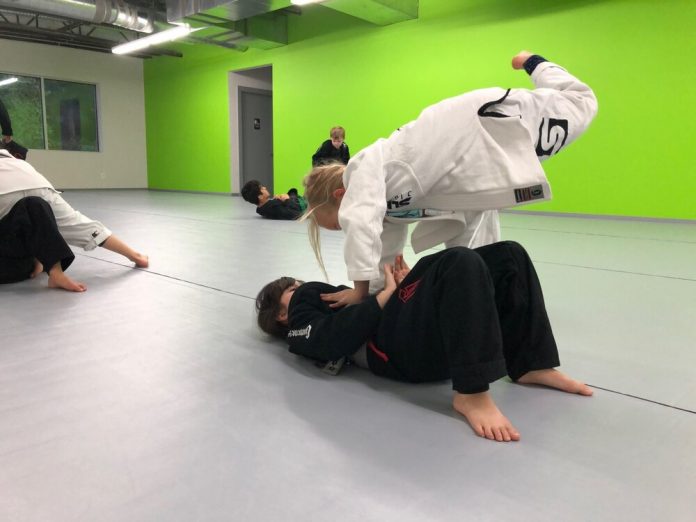
Getting past the legs of a supine opponent in Brazilian Jiu-Jitsu is one of the most difficult things you’ll do. If you look at any BJJ match or roll, you’ll notice that here’s a pass vs. guard battle at some point, if not throughout the entire match/roll. The nature of the sport means that one person is on the bottom and the other on top, which all but guarantees that involvement of guards to a certain point. That’s why there are just as many passes as there are guards, If not more. Finding one that will help you get past more than one guard is usually a great idea. So, why not look into the BJJ X pass? It is simple, effective, and easy to combine with other movements.
The BJJ X pass is one of those guard passes that people don’t really like to use too much until they reach a more advanced level. The reason is, in my experiences, that the pass seems overly simplistic, and it seems like it won’t work. Evidence points to the contrary, from rolling to high-level competition matches between some of the greatest grapplers ever. The BJJ X Pass is straightforward but powerful. It is simple but gracious. And, it takes hours upon hours of drilling to get it right and manage to perform it against everyone. Once you have it, though, it will be smooth passing from thereon.
What Is The X Pass?
The X pass is a simple pass you’ve probably tried, or drilled even If you’re fairly new to Jiu-Jitsu. It is a loose pass, involving lots of footwork, which is probably why people tend to stay away from it, initially. Later on, it seems like it is too simple to work. It kind of creates an environment where people distrust the pass until they realize it actually does deliver on its promises and then some.
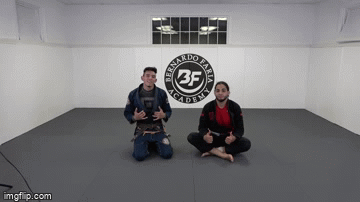
The starting position of the pass is with one leg in between yours. It is somewhat similar to Rafael Lovato’s “headquarters” position. You can be as low or high as you want, but the goal is to have both feet on the ground, which places the X pass in the “standing guards” category. Speaking of categories, apart from being a standing pass, and a loose pass, in terms of directions it is a pass that gets you past the legs by taking you around them.
The pass itself works when you take the leg that is in between the opponent’s legs (technically, the leg in guard) and kick it backward, forcefully. Staying on one leg, you then step right next to the butt of the opponent. While using that all-important grip on the knee of the near side leg to make sure their hips remain pinned. Side control, knee on belly, or even mount are available from that point on.
Using The X Pass From Beginner To Advanced
The pass seems simple, and it is, but it does have plenty of moving parts. First of all, there’s footwork involved which always translates to lots and lots of drills. More on that later. The key thing to remember is that you need to keep your balance. That means, that apart from drilling, you need to start at the bottom of the stairs and build your way up.
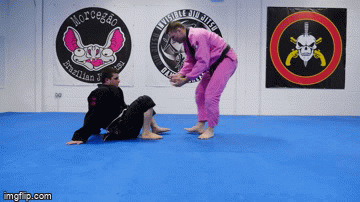
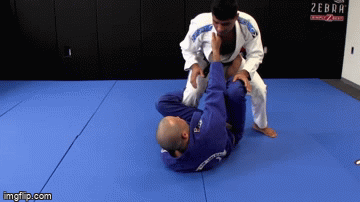
BJJ X Pass Drills
To be honest, I absolutely, utterly hated doing X pass drills when I was a blue and purple belt. Later on, it became apparent why my instructor insisted on them. Nowadays, I’m the one insisting people do the drills, and I can see it in their faces that not many people enjoy them. That said, drills are of the utmost importance, particularly in the case of the BJJ X pass. It is not just the footwork, but also figuring out the balance during the kick, the angle of blocking the hips, stiff-arming the leg, and a bunch of other details that take time. Conversely, you can shorten the learning curve of the X pass from years to months if you use the following drills, instead of just trying it out in rolls.
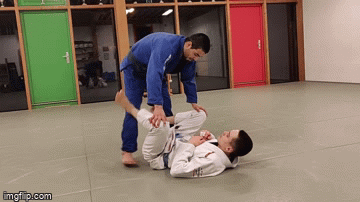

Next up would be connecting the two. In other words, once you’re comfortable with shin circles and the BJJ X pass kick back, you can do them in a sequence., Do a shin circle, go straight to the kick, come back, and reset so you start with a shin circle again. Only when you’re comfortable with these motions, should you add the final piece – going into side control or knee on belly from the finishing position of the kick back drills.
Conclusion
The BJJ X Pass really is a pass for any occasion. Backing out of half guard? X Pass. Just opened a closed guard? X pass. Broke out of Spider guard? X pass. You catch my drift. Settling two major questions about the X pass, the answers are yes. Yes, it will work at every belt level and under plenty of different circumstances. And, yes, it will take a lot of drilling to perfect the motions and footwork, not mentioning the balance component. It will be well worth it in the end, though.


![Darce Choke Encyclopedia – Origins, Mechanics and Variations [2025] BJJ, choke, Brabo, BJJ Darce Choke, D'arce Choke, Darce BJJ Choke](https://bjj-world.com/wp-content/uploads/2017/11/JungPoirierLeeYahoo-218x150.jpg)









![Get Off My Legs Gringo Craig Jones DVD Review [2025] Get Off My Legs Gringo Craig Jones DVD Review](https://bjj-world.com/wp-content/uploads/2025/03/get-off-my-legs-gringo-craig-jones-dvd-review-218x150.png)

![Leg Lock Entries Helena Crevar DVD Review [2025] Leg Lock Entries Helena Crevar DVD Review](https://bjj-world.com/wp-content/uploads/2025/03/leg-lock-entries-helena-crevar-dvd-review-218x150.png)
![Special K Guard Neil Melanson DVD Review [2025] Special K Guard Neil Melanson DVD Review](https://bjj-world.com/wp-content/uploads/2025/03/special-k-guard-neil-melanson-dvd-review-218x150.png)
![Arm Bar It All Shawn Melanson DVD Review [2025] Arm Bar It All Shawn Melanson DVD Review](https://bjj-world.com/wp-content/uploads/2025/03/arm-bar-it-all-shawn-melanson-dvd-review-218x150.png)


![Leg Lock Strategies: Navigating Entanglements Jack Stapleton DVD Review [2024] Leg Lock Strategies: Navigating Entanglements Jack Stapleton DVD Review](https://bjj-world.com/wp-content/uploads/2024/12/navigating-entanglements-jack-stapleton-dvd-review-100x70.png)
![Charles Allan Price Building Workouts For BJJ DVD Review [2024] Charles Allan Price Building Workouts For BJJ DVD Review](https://bjj-world.com/wp-content/uploads/2024/09/charles-allan-price-building-workouts-for-bjj-review-100x70.png)
![Old School BJJ Ricardo Cavalcanti Fundamentals DVD Review [2024] Old School BJJ Ricardo Cavalcanti Fundamentals DVD Review](https://bjj-world.com/wp-content/uploads/2024/09/old-school-bjj-ricardo-cavalcanti-dvd-preview-100x70.png)


![Arm Bar It All Shawn Melanson DVD Review [2025] Arm Bar It All Shawn Melanson DVD Review](https://bjj-world.com/wp-content/uploads/2025/03/arm-bar-it-all-shawn-melanson-dvd-review-100x70.png)

![Efficiently Executing X-Guard Giancarlo Bodoni DVD Review [2024] Efficiently Executing X-Guard Giancarlo Bodoni DVD Review](https://bjj-world.com/wp-content/uploads/2024/09/efficiently-executing-x-guard-giancarlo-bodoni-dvd-REVIEW-100x70.png)
![Kill The Underhook Dima Murovanni DVD Review [2024] Kill The Underhook Dima Murovanni DVD Review](https://bjj-world.com/wp-content/uploads/2024/10/kill-the-underhook-dima-murovanni-dvd-review-100x70.png)






![The Stack Pass Andre Galvao DVD Review [2025] The Stack Pass Andre Galvao DVD Review](https://bjj-world.com/wp-content/uploads/2025/01/the-stack-pass-andre-galvao-dvd-review-100x70.png)
![Just Pass Jay Rodriguez DVD Review [2024] Just Pass Jay Rodriguez DVD Review](https://bjj-world.com/wp-content/uploads/2024/11/just-pass-jay-rodriguez-dvd-review-100x70.png)
![Eoghan O’Flanagan Bundle Down Right Sloppy Jiu-Jitsu Review [2024] Eoghan O'Flanagan Bundle Down Right Sloppy Jiu-Jitsu Review 2024](https://bjj-world.com/wp-content/uploads/2024/09/down-right-sloppy-jiu-jitsu-eoghan-oflanagan-bundle-100x70.png)

![Get Off My Legs Gringo Craig Jones DVD Review [2025] Get Off My Legs Gringo Craig Jones DVD Review](https://bjj-world.com/wp-content/uploads/2025/03/get-off-my-legs-gringo-craig-jones-dvd-review-100x70.png)
![Dynamic Headquarters Passing Jason Rau DVD Review [2024] Dynamic Headquarters Passing Jason Rau DVD Review](https://bjj-world.com/wp-content/uploads/2024/10/dynamic-headquarters-passing-jason-rau-dvd-review-100x70.png)
![The Rack Kyle Watson BJJ DVD Review [2025] The Rack Kyle Watson BJJ DVD Review](https://bjj-world.com/wp-content/uploads/2024/12/the-rack-kyle-watson-bjj-dvd-review-100x70.png)

![No-Gi Pressure Mastery JT Torres DVD Review [2024] No-Gi Pressure Mastery JT Torres DVD Review](https://bjj-world.com/wp-content/uploads/2024/10/no-gi-pressure-mastery-jt-torres-dvd-review-100x70.png)
![Reverse Armlock Magid Hage DVD Review [2024] Reverse Armlock Magid Hage DVD Review](https://bjj-world.com/wp-content/uploads/2024/12/reverse-armlock-magid-hage-dvd-review-100x70.png)
![Highlight Hip Throws Christian Ozbek DVD Review [2025] Highlight Hip Throws Christian Ozbek DVD Review](https://bjj-world.com/wp-content/uploads/2025/01/highlight-hip-throws-christian-ozbek-dvd-review-100x70.png)
![Complete Fundamentals Curriculum Eliot Marshall DVD Review [2025] Complete Fundamentals Curriculum Eliot Marshall DVD Review](https://bjj-world.com/wp-content/uploads/2025/02/fundamentals-curriculum-eliot-marshall-dvd-review-100x70.png)
![Zen Guide To Submission Grappling Margot Ciccarelli DVD Review [2025] Zen Guide To Submission Grappling Margot Ciccarelli DVD Review](https://bjj-world.com/wp-content/uploads/2025/02/submission-grappling-margot-ciccarelli-dvd-preview-100x70.png)